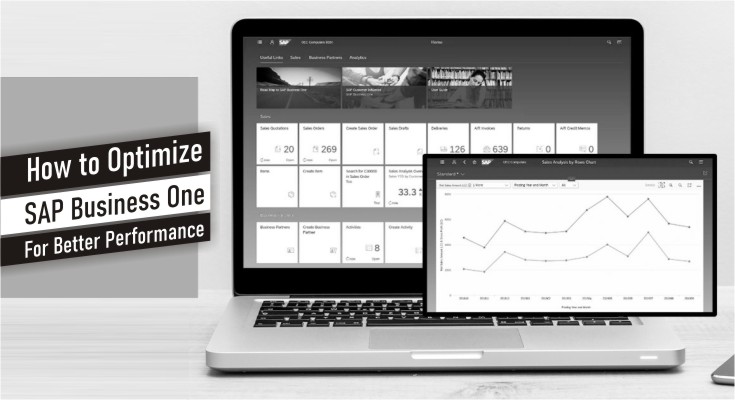SAP Business One is a powerful Enterprise Resource Planning (ERP) solution designed for small to medium-sized enterprises (SMEs). It provides a comprehensive suite of tools that streamline business processes, helping companies manage everything from finance and accounting to sales and inventory. However, like any other ERP system, performance can degrade over time if not properly managed. Optimizing SAP Business One for better performance is crucial for ensuring the system runs smoothly and that it can support business growth efficiently.
Why Performance Matters
Performance optimization is critical for any ERP system because slow or unstable systems can severely affect daily operations. Sluggish performance can cause delays in processing transactions, generating reports, or even affect user experience, leading to decreased productivity. Ensuring that SAP Business One runs efficiently helps reduce downtime, speeds up workflows, and enhances the user experience.
Here are some actionable strategies for optimizing SAP Business One performance:
1. Ensure Proper System Sizing
SAP Business One’s performance relies heavily on the infrastructure it runs on. The first step in optimization is to ensure the hardware and system specifications meet the demands of the software. As your business grows, so does the volume of data and the number of users accessing the system.
- CPU and Memory: Make sure that your servers have sufficient processing power and RAM. SAP recommends using multi-core processors and ensuring that memory is properly allocated based on the number of users and modules in use.
- Disk Space and Speed: Ensure that there is enough disk space for database storage and that the disks are high-speed. Using SSDs (Solid-State Drives) instead of traditional HDDs can significantly speed up database access times.
- Network Bandwidth: For users accessing SAP Business One remotely, a fast and stable internet connection is essential. Consider upgrading network equipment and ensuring that network bandwidth is sufficient for the number of concurrent users.
2. Optimize Database Performance
SAP Business One relies heavily on databases like Microsoft SQL Server or SAP HANA. Database optimization is a crucial factor in improving the system’s overall performance. Here are some steps to enhance database performance:
- Index Management: Proper indexing can drastically improve query performance. Regularly monitor and maintain database indexes, especially on large tables, to ensure queries run quickly and efficiently.
- Database Partitioning: Large databases can slow down performance. Partitioning data into smaller segments can improve query performance by making data retrieval more efficient.
- Regular Backups and Maintenance Plans: Establish regular database maintenance plans, including backups, defragmentation, and integrity checks. This ensures that the database remains healthy and performs optimally.
- Optimize Queries: Ensure that frequently used queries are optimized. Long or complex queries may take more time to execute, leading to slow performance. Analyze query performance using SQL tools and optimize where possible.
3. Regular System Health Checks and Monitoring
Conduct regular health checks of your SAP Business One system to identify performance bottlenecks early. SAP provides various monitoring tools that can help you identify issues before they become critical. Some of the tools include:
- SAP Business One System Landscape Directory (SLD): It monitors the overall health of the system, including CPU usage, memory usage, and disk space.
- SAP HANA Cockpit: If you’re using SAP HANA, the cockpit provides a real-time overview of database performance, including resource usage, memory allocation, and query performance.
- SQL Profiler: For SQL-based implementations, SQL Profiler can help track slow-running queries and detect locking or blocking issues.
By regularly monitoring system health, you can proactively address performance issues before they impact business operations.
4. Fine-Tune SAP Business One Configurations
The software itself comes with various settings that can be adjusted to optimize performance:
- Session Management: Limit the number of active sessions to reduce the load on the server. Close inactive sessions regularly and prevent users from opening multiple sessions simultaneously.
- Form Settings: Adjusting form settings can optimize how SAP Business One loads data. For example, if a form frequently loads large datasets, reducing the number of rows or records displayed by default can improve speed.
- Batch Processing: Schedule batch processes (such as reporting or MRP runs) during off-peak hours. This ensures that these resource-heavy processes don’t slow down the system during critical business hours.
- Use the Right Add-Ons: Third-party add-ons can greatly enhance functionality, but they can also slow down your system if they are not optimized. Only use essential add-ons and make sure they are updated to the latest versions.
5. Upgrade to the Latest Version
Keeping your SAP Business One system up to date is one of the simplest and most effective ways to improve performance. SAP frequently releases updates and patches that include performance enhancements, bug fixes, and new features.
- Version Compatibility: Make sure that your hardware, operating system, and database management system are compatible with the version of SAP Business One you’re using.
- Patch Management: Regularly apply patches and hotfixes provided by SAP. These updates often address performance issues and security vulnerabilities that could impact the system.
6. Utilize SAP HANA for Advanced Performance
If you’re still using SQL Server, consider migrating to SAP HANA, SAP’s in-memory computing platform designed for high performance. SAP HANA can significantly speed up database queries and data processing times due to its real-time data processing capabilities.
- Real-Time Analytics: SAP HANA allows for faster data analytics and reporting, making it ideal for businesses that rely on real-time decision-making.
- Compression and Faster Processing: By storing data in-memory and using advanced compression techniques, SAP HANA can improve both read and write operations compared to traditional disk-based databases.
7. Train Users to Work Efficiently
Sometimes performance bottlenecks are a result of inefficient system usage. Training employees to use SAP Business One more effectively can help:
- Efficient Data Entry: Users should be trained to enter data correctly and efficiently to avoid redundant or inaccurate data entries that slow down processes.
- Understand System Limits: Users should also understand system limitations, such as the maximum number of records that can be loaded in a single report, and how to filter data appropriately to avoid overloading the system.
8. Use Virtualization Wisely
Virtualization can provide flexibility and resource optimization, but it needs to be configured properly to ensure it doesn’t degrade performance. Allocate sufficient resources (CPU, memory, and storage) to your virtual machines running SAP Business One, and avoid overcommitting resources.
Conclusion
Optimizing SAP Business One for better performance is an ongoing process that involves regular system monitoring, hardware upgrades, software updates, and user training. By focusing on infrastructure, database management, system configurations, and user efficiency, you can ensure that SAP Business One continues to meet the needs of your growing business. With the right strategies in place, you can boost performance, enhance user satisfaction, and ensure that your ERP system operates at peak efficiency.


